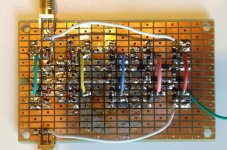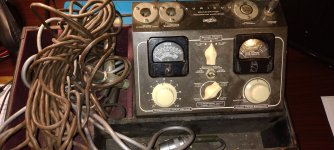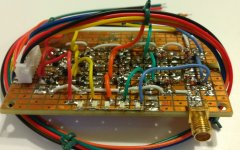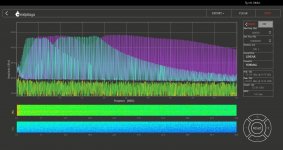You eve n posted the link:I remember, there was a similar system by DJ7VY.
More on propagation -- my son reports that he has been working all over the world on 10 meters, Even the CB band (11 meters) was alive all over the world late this afternoon!
I just did read that there was a Mögel-Dellinger effect
last week ("The Quiet 20 minutes") on short waves due to the large scale
gamma burst (BOAT - Biggest One all Times).
last week ("The Quiet 20 minutes") on short waves due to the large scale
gamma burst (BOAT - Biggest One all Times).
Last edited:
I saw the activity too but here, CB and 28-30 MHz have been open most afternoons for the past week too. Occasionally even German DRM 15785k at dawn but SN indicator not higher than ~8 dB, not enough for copy.
The 1N4148 diodes seem satisfactory for switching at HF. I used some AliExpress 100 / $1 USD SOD-323 devices for the last three filters. They also seem to work just fine. I can't tell any difference in the frequency response of the filters before and after adding the switches. The isolation looks good, or at least more than the RP can see.
I'm less pleased with the actual bandpass. I wound up with:
0 - 2.85 MHz (OK);
2.75 MHz to 6.75 MHz (OK);
6.0 to 16 MHz (wider than I wanted);
13-26 MHz (wider than I wanted);
24 -30 (narrower than I wanted)
I may set up a test board so I can tinker with the values and get a better understanding of how changes in the component values influence the shape of the filter.
Win W5JAG
Attachments
Last edited:
From April 17, 2018 ...
... The real irritant in my life right now is some abandoned underground storage tanks - and whose property they are actually located on: mine, or a sovereign state.
Now, almost three years later, this thing continues to be a real irritant in my life. They've filed two lawsuits against me, one of which is set for trial this coming week. It's been postponed many times, and may be again, but I likely won't be able to work on the hobby thing this week.
Now, after another couple of years, just received final word today - I WON and wound up with another ten feet or so of property.
The government can be beat, but it sure is a grueling process.
Win W5JAG
https://www.diyaudio.com/community/...-i-need-a-project.392287/page-15#post-7189495
"We" are building first AM transmitter. 🤔
🤔
"We" are building first AM transmitter.
 🤔
🤔One of the artifacts of having practiced so long and having so much old ham equipment on prominent display in my office, is that clients just bring me "stuff".
A fellow I represented a few years ago just delivered this to my office. Anyone have any idea what it is?
Win W5JAG
A fellow I represented a few years ago just delivered this to my office. Anyone have any idea what it is?
Win W5JAG
Attachments
A preamp for film recording, as it says on the plate. With dials for correct volume etc.One of the artifacts of having practiced so long and having so much old ham equipment on prominent display in my office, is that clients just bring me "stuff".
A fellow I represented a few years ago just delivered this to my office. Anyone have any idea what it is?
Win W5JAG
Member
Joined 2009
Paid Member
The hardbound version?just got the ARRL 100yr handbook - wow, simply wonderful!
I still have my 1964 edition, and some artifacts from projects built from it!
Member
Joined 2009
Paid Member
yes, hardbound. It came with some free gifts, a repeater directory (I guess N.A. only), some cool stickers, what looks like a dog leash, a lightweight backpack and one other thing. The book is big and heavy and simply jammed full of useful stuff. The paper isn't the best possible quality but I've no issues about that. Of course, I don't understand half of what is in this book so the fun part will be learning a whole bunch of new stuff (I'm not even yet a licensed operator). I'm very glad I bought it.
One thing I have worked out already. For radio operators the antenna is 90% of the performance of the system. Kind of like the speakers are for us audio people. And just like speakers, the antenna has tradeoffs between efficiency, size and frequency range - which we all know means mostly that Bigger is better. The radio folk also have their own analogue vs digital and transistor vs tube discussions but refreshingly little, if any, snake oil to be found from what I've seen so far.
One thing I have worked out already. For radio operators the antenna is 90% of the performance of the system. Kind of like the speakers are for us audio people. And just like speakers, the antenna has tradeoffs between efficiency, size and frequency range - which we all know means mostly that Bigger is better. The radio folk also have their own analogue vs digital and transistor vs tube discussions but refreshingly little, if any, snake oil to be found from what I've seen so far.
Two guys in Alaska have written a book, the thesis is that directional receiving antennas with a low noise amplifier and a separate transmitting antenna cure a lot of problems.<SNIP>
One thing I have worked out already. For radio operators the antenna is 90% of the performance of the system.<SNIP>
Me. I have an MFJ-1778 GRV given to me by eldest son...but I still have to renew my license!
The full size G5RV works really well on 20 meters.
I really like the SteppIR antennas. Being able to push a button and go from an optimized forward beam, to bidirectional with gain, or a 180 degree reverse in milliseconds is just awesome. I'd like to have a second one for the office but they have become eye wateringly expensive for casual use.
I bought a RadioWavz 20 meter double bazooka to set up at the lake house - been using a portable Buddipole deluxe there. I see they have come out with a hex beam that looks interesting.
Win W5JAG
I really like the SteppIR antennas. Being able to push a button and go from an optimized forward beam, to bidirectional with gain, or a 180 degree reverse in milliseconds is just awesome. I'd like to have a second one for the office but they have become eye wateringly expensive for casual use.
I bought a RadioWavz 20 meter double bazooka to set up at the lake house - been using a portable Buddipole deluxe there. I see they have come out with a hex beam that looks interesting.
Win W5JAG
I tweaked around on the bandpass filters some, and have wound up with (at -3 dB endpoints):
0 - 2.85 MHz
2.75 - 6.75 MHz
4.9 - 12.5 MHz
9 - 18.5 MHz, and
19.5 - 30 Mhz
So, I'm going to leave it be for now.
With the demise of WTWW, and all the ham radio / oldies / classic rock programming moving to WRMI, the 9 KHz second IF was just too wide for the weaker signal strengths on their frequencies at my QTH. I seem to be right in between the 31 meter beam patterns and at a less than optimal distance. The beam to latin / south America on 4980 KHz starting at 0200 UTC comes in well, even though I am on the backside, but it is still typically about 40 dB less than WTWW was at this location. I put in a 455 KHz 6 Khz bandwidth filter, which has, surprisingly, really boosted the MW performance. The little receiver is comfortably hearing all of the stations Radio Locator lists as receivable in this area, including the DX stations, and right now at 1530 UTC I have Q5 copy on a 50 KW station north of Cedar Rapids, Iowa. Which seems like good reception for only two transistors and an IC active at RF.
With the second IF now at 455 KHz instead of 450 KHz, if I get motivated, I can make the second LO crystal controlled, and get rid of that second channel crosstalk in the Si5351, which might make another improvement in reception.
Win W5JAG
0 - 2.85 MHz
2.75 - 6.75 MHz
4.9 - 12.5 MHz
9 - 18.5 MHz, and
19.5 - 30 Mhz
So, I'm going to leave it be for now.
With the demise of WTWW, and all the ham radio / oldies / classic rock programming moving to WRMI, the 9 KHz second IF was just too wide for the weaker signal strengths on their frequencies at my QTH. I seem to be right in between the 31 meter beam patterns and at a less than optimal distance. The beam to latin / south America on 4980 KHz starting at 0200 UTC comes in well, even though I am on the backside, but it is still typically about 40 dB less than WTWW was at this location. I put in a 455 KHz 6 Khz bandwidth filter, which has, surprisingly, really boosted the MW performance. The little receiver is comfortably hearing all of the stations Radio Locator lists as receivable in this area, including the DX stations, and right now at 1530 UTC I have Q5 copy on a 50 KW station north of Cedar Rapids, Iowa. Which seems like good reception for only two transistors and an IC active at RF.
With the second IF now at 455 KHz instead of 450 KHz, if I get motivated, I can make the second LO crystal controlled, and get rid of that second channel crosstalk in the Si5351, which might make another improvement in reception.
Win W5JAG
By alternating the inputs on the Red Pitaya, and allowing the signal generator to sweep 0 - 50 MHz, I made a crude graph showing how the filters overlay. I've got an undesired dip at 19 MHz, and I don't like the response of the highest filter - it's OK to 25 MHz, but down 3 dB at 30 MHz. I don't know if this is poor component tolerance because the inductor values are pretty small here, crude measurement equipment/ technique, or something else. The low pass filter for MW / 160 meters is not shown here.
On the other hand, the switching works well, and five HF bands easily fit on one 50 x 80 mm board.
I'll use a 5 volt line to switch the filters, and a color coded, brightness equalized, LED for each band shows when it is active.
Win W5JAG
On the other hand, the switching works well, and five HF bands easily fit on one 50 x 80 mm board.
I'll use a 5 volt line to switch the filters, and a color coded, brightness equalized, LED for each band shows when it is active.
Win W5JAG
Attachments
Gotta smile when searching for basic RF info and a DIY Audio link is on the first page of results 🙂
In reading about how gain vs power works I am getting tripped up on the practical aspects of how this is implemented. For example, if you start with a low power signal, say 10mW, and you reach a final output of 10W, how many interim stages are usually needed? What if the power is stepped up to 100W, will that require every stage up to and including the 10W stage? Or can you go from 10mW to 10W, or 100W, or 1000W in just a couple of stages from the 10mW input signal?
In reading about how gain vs power works I am getting tripped up on the practical aspects of how this is implemented. For example, if you start with a low power signal, say 10mW, and you reach a final output of 10W, how many interim stages are usually needed? What if the power is stepped up to 100W, will that require every stage up to and including the 10W stage? Or can you go from 10mW to 10W, or 100W, or 1000W in just a couple of stages from the 10mW input signal?
For HF?
As a practical matter, it took me two single ended class A stages to go from the milliwatt level mixer output to a solid one watt RF output with manageable heat and (probably) legal harmonic content at the antenna port. I think the heatsinking on my output stage is marginal.
I would expect it to take two more push pull stages to get to 100 watts output with manageable heat and legal harmonic content.
If you don't need it to be linear, it would be simpler. Vacuum tube radios typically only needed a high gain video driver tube and a pair of 6146 or other sweep tubes in parallel. Sometimes only a single sweep tube like a 6KD6 could do the job.
I'm just a ham - there are real RF engineers here in the thread that could better answer your query.
Win W5JAG
As a practical matter, it took me two single ended class A stages to go from the milliwatt level mixer output to a solid one watt RF output with manageable heat and (probably) legal harmonic content at the antenna port. I think the heatsinking on my output stage is marginal.
I would expect it to take two more push pull stages to get to 100 watts output with manageable heat and legal harmonic content.
If you don't need it to be linear, it would be simpler. Vacuum tube radios typically only needed a high gain video driver tube and a pair of 6146 or other sweep tubes in parallel. Sometimes only a single sweep tube like a 6KD6 could do the job.
I'm just a ham - there are real RF engineers here in the thread that could better answer your query.
Win W5JAG
- Home
- Member Areas
- The Lounge
- No RF gear here?




